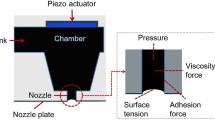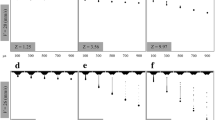Abstract
Computational fluid dynamics and micro-flow visualization (μ-FV) have been complementarily performed to study the evolution of a single droplet ejected from a bend-mode piezoelectric inkjet printhead. The numerical simulation is characterized by the coupled piezoelectric-structural-fluid solution procedure and verified by the μ-FV results. The in-house numerical code is subsequently applied to investigate the influences of electric voltage φ pp, pulse shape, ink property, and nozzle diameter D n on the droplet volume, velocity, and configurations. φ pp studied ranges from 14 to 26 V and pulse shape is explored by varying the key time intervals with fixed voltage slopes. The influence of ink property is examined by investigating the dynamic viscosity μ and surface tension σ separately. Investigation on the effects of nozzle diameter is also conducted by decreasing D n from 26 to 11 at 3 μm interval. The computed results are found in good agreement with the experimental ones. New findings are to discover the critical ranges of electric waveform parameters, μ, and σ outside which the phenomena of satellite droplets and puddle formation at the nozzle opening are absent. In addition, the imbedded physical rationales for these critical ranges are provided. The results are also new in terms of the identifications of the critical σ and D n for the reference of improving the droplet quality.















Similar content being viewed by others
References
Asai A (1992) Three-dimensional calculation of bubble growth and drop ejection in a bubble jet printer. J. Fluids Eng 114:638–641
Asai A, Hara T, Endo I (1987) One dimensional model of bubble growth and liquid flow in bubble jet printers. Jpn J Appl Phys 20:1794–1801
Asai A, Hirasawa S, Endo I (1988) Bubble generation mechanism in the bubble jet recording process. J Imaging Technol. 14:120–124
Bogy DE, Talke FE (1984) Experimental and theoretical study of wave propagation phenomena in drop-on-demand ink jet devices. IBM J Res Dev 28:314–321
Brackbill JU, Kothe DB, Zemach C (1992) A continuum method for modeling surface tension. J Comput Phys 100:335–354
Challinor A (2004) Xaar launches new high-performance XJ128 printhead XAAR. http://www.xaar.co.uk/news_det.asp?art_id=5100&sec_id=2580
Chen PH, Chen WC, Ding PP, Chang SH (1998) Droplet formation of a thermal sideshooter inkjet printhead. Int J Heat Fluid Flow 19:382–390
Chen PH, Peng HY, Liu HY, Chang SL, Wu TI, Cheng CH (1999) Pressure response and droplet ejection of a piezoelectric inkjet printhead. Int J Mech Sci 41:235–248
Chen CC, Chen SH, Chung CK, Chan CY, Liou TM (2002) 3D flow simulation of a micro droplet generator study on actuator shape effect. J Flow Vis Image Process 3:963–968
Elrod SA, Khuri-Yakub BT, Quake CF (1997) Stabilization of the free surface of a liquid. US Patent 5,629,724
Fromn JE (1984) Numerical calculation of the fluid dynamics of drop-on-demand jets. IBM J Res Dev 28:323–333
Khosla PK, Rubin SG (1974) A diagonally dominant second-order accurate implicit scheme. Comput Fluids 2:207–209
Knupp P, Margolin L, Shashkov M (2002) Reference Jacobian optimization-based rezone strategies for arbitrary Lagrangian Eulerian methods. J Comput Phys 176:93–128
Liou TM, Chan CY, Fu CC, Shih KC (2008) Effects of impact inertia and surface characteristics on deposited polymer droplets in microcavities. J Microelectromech Syst 17:278–287
Macler M, Nelson C (2005) Surface characteristic apparatus and method. US Patent 6,938,986
Meinhart CD, Zhang H (2000) The flow structure inside a microfabricated inkjet printhead. J Microelectromech Syst 9:67–75
Muzaferija S, Perić M (1998) Computation of free-surface flows using interface-tracking and interface-capturing methods. Nonlinear water wave interaction. Computational Mechanics Publications, Southampton
Pak YE (1992) Linear electro-elastic fracture mechanics of piezoelectric materials. Int J Frac 54:79–100
Pan F, Kubby J, Chen J (2002) Numerical simulation of fluid-structure interaction in a MEMS diaphragm drop ejector. J Micromech Microeng 12:70–76
Patankar SV (1980) Numerical heat transfer and fluid flow. Hemisphere, Washington DC
Perić M, Ferziger JH (1996) Computational methods for fluid dynamic. Springer, Berlin
Sayama T, Yonekubo S (1998) Device for driving inkjet print head. US Patent 6,074,033
Sen AK, Darabi J (2007) Droplet ejection performance of a monolithic thermal inkjet print head. J Micromech Microeng 17:1420–1427
Shield TW, Bogy DB, Talke FE (1987) Drop formation by DOD ink-jet nozzles: a comparison of experiment and numerical simulation. IBM J Res Dev 31:96–110
Tseng FG, Kim CJ, Ho CM (2002) A high-resolution high-frequency monolithic top-shooting microinjector free of satellite drops. Part I. Concept, design, and model. J Microelectromech Syst 11:427–436
Wijshoff H (2004) Free surface flow and acousto-elastic interaction in piezo inkjet. Proc Nanotechnol 2:215–218
Wu HC, Hwang WS, Lin HJ (2004) Development of a three-dimensional simulation system for micro-inkjet and its experimental verification. Mater Sci Eng A 373:268–278
Wu CL, Torniainen ED, Taylor MS (2008) Hydrophobic nozzle exit with improved micro fluid ejection dynamics. US Patent 7,377,620
Yeh JT (2001) A VOF-FEM and coupled PLED inkjet simulation. In: Proceedings of ASME fluids engineering division summer meeting, New Orleans, pp 1–5
Acknowledgments
The study is sponsored by the MOE Program for Promoting Academic Excellence of Universities under the grant number: 91-E-FA04-2-4A and by the NSC Program under the grant number: NSC 97-2221-E-007-036-MY3.
Author information
Authors and Affiliations
Corresponding author
Rights and permissions
About this article
Cite this article
Liou, TM., Chan, CY. & Shih, KC. Effects of actuating waveform, ink property, and nozzle size on piezoelectrically driven inkjet droplets. Microfluid Nanofluid 8, 575–586 (2010). https://doi.org/10.1007/s10404-009-0488-4
Received:
Accepted:
Published:
Issue Date:
DOI: https://doi.org/10.1007/s10404-009-0488-4




